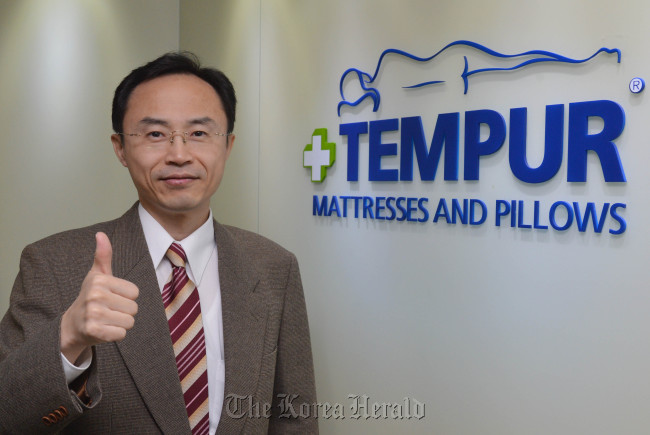Top-end mattress sales bounce as more Koreans seek quality sleep
Local chief says Tempur popular in markets that highly value quality of life including Korea
By Korea HeraldPublished : Jan. 14, 2013 - 20:22
Like Coca-Cola, nobody knows what it is made of.
The viscoelastic material was initially developed to cushion and support astronauts’ backs from the massive pressure during lift-off in the early 1970s.
The pressure-absorbing material was temperature-sensitive and it evenly distributed body weight. NASA released this material to the public in the 1980s.
It took about a decade for scientists in Sweden to develop it into Tempur material for use in mattresses.
Ju Jong-kyu, chief of the Korean arm of Tempur-Pedic International, Inc., sold thousands of Tempur mattresses in Korea last year, achieving more than triple the sales in 2011 on growing brand awareness and increased sales channels.
“The timing of Tempur Korea’s launch in 2011 seems to have corresponded with Korean consumers’ growing desire to sleep well,” Ju told The Korea Herald.
“Having been widely used for medical purposes as it prevents bedsores and helps ease back pains such as spinal disc herniation, Tempur attracts consumers with high concerns for health and sound sleep.”
Despite the high price, ranging from 1.6 million won to 6.8 million won per mattress, the awareness of the Tempur brand in Korea, which used to be sold by a local importer prior to April 2011, surged 10 percent in just six months last year, according to a survey by Tempur headquarters.
“The increased number of our distributors ― from 42 in 2011 to 100 by the end of last year ― as well as greater investment in sales staff and a month of television commercials helped raise both awareness and sales,” Ju said.
“Thanks to more investment, our distributors’ sales skills improved, with some stores’ sales jumping by six-fold.”
The viscoelastic material was initially developed to cushion and support astronauts’ backs from the massive pressure during lift-off in the early 1970s.
The pressure-absorbing material was temperature-sensitive and it evenly distributed body weight. NASA released this material to the public in the 1980s.
It took about a decade for scientists in Sweden to develop it into Tempur material for use in mattresses.
Ju Jong-kyu, chief of the Korean arm of Tempur-Pedic International, Inc., sold thousands of Tempur mattresses in Korea last year, achieving more than triple the sales in 2011 on growing brand awareness and increased sales channels.
“The timing of Tempur Korea’s launch in 2011 seems to have corresponded with Korean consumers’ growing desire to sleep well,” Ju told The Korea Herald.
“Having been widely used for medical purposes as it prevents bedsores and helps ease back pains such as spinal disc herniation, Tempur attracts consumers with high concerns for health and sound sleep.”
Despite the high price, ranging from 1.6 million won to 6.8 million won per mattress, the awareness of the Tempur brand in Korea, which used to be sold by a local importer prior to April 2011, surged 10 percent in just six months last year, according to a survey by Tempur headquarters.
“The increased number of our distributors ― from 42 in 2011 to 100 by the end of last year ― as well as greater investment in sales staff and a month of television commercials helped raise both awareness and sales,” Ju said.
“Thanks to more investment, our distributors’ sales skills improved, with some stores’ sales jumping by six-fold.”

Tempur is now sold in 40 department stores nationwide and 60 furniture stores.
Tempur-Pedic has two factories in the U.S. and one in Denmark which produces all the mattresses sold outside the U.S.
The company’s supply fell short of the increasing local demand in the second half of last year, and some customers had to wait for three months to get their mattresses delivered from Denmark.
“The company’s target markets are countries with over $20,000 in GDP per capita where quality of life including health is highly valued. Our sales rise sharply once the per capita income goes over $30,000,” the managing director said.
“Aside from the U.S., Tempur mattresses sell well in Britain, France, Germany and Japan. It opened in China a year earlier than in Korea, but brand awareness is still low.”
Korea’s per capita income is just above $20,000, but its purchasing power parity hovers around $29,000, higher than $28,000 of Australia, which has a much greater per capita income of $45,000, because of higher prices there, Ju added.
NASDAQ-listed Tempur-Pedic keeps a close watch on its global sales through semiannual conferences of managing directors, quarterly reviews and weekly or biweekly conference calls for managing directors.
Tempur is currently the world’s No. 1 mattress brand in sales.
In the U.S., the mainstream of mattresses has moved from spring mattresses to foam mattresses like Tempur, according to Ju.
Tempur mattresses come in three collections in Korea: original, sensation and cloud.
Sensation is firmer than the original Tempur material, which hardens slightly at low temperatures; cloud is softer than original and stays soft even when it’s cold.
“Young people tend to prefer the Cloud collection, while senior customers like Sensation. The rest mostly choose the original,” Ju said.
Tempur Korea’s plan this year is to achieve double-digit growth by unveiling a variety of new products and running a TV commercial.
Tempur Korea also sells electronic bed bases that can be tilted up and down as well as back and forth to achieve a zero-gravity feeling for the user.
It also sells a variety of pillows, toppers, cushions including those for women who have just given birth, and futons.
“While I am heading Tempur Korea, my goal is to reach hundreds of billions of won in sales,” Ju said.
By Kim So-hyun (sophie@heraldcorp.com)
-
Articles by Korea Herald








![[KH Explains] No more 'Michael' at Kakao Games](http://res.heraldm.com/phpwas/restmb_idxmake.php?idx=644&simg=/content/image/2024/04/28/20240428050183_0.jpg&u=20240428180321)



![[Weekender] How DDP emerged as an icon of Seoul](http://res.heraldm.com/phpwas/restmb_idxmake.php?idx=644&simg=/content/image/2024/04/25/20240425050915_0.jpg&u=)






![[Herald Interview] Mistakes turn into blessings in street performance, director says](http://res.heraldm.com/phpwas/restmb_idxmake.php?idx=652&simg=/content/image/2024/04/28/20240428050150_0.jpg&u=20240428174656)
